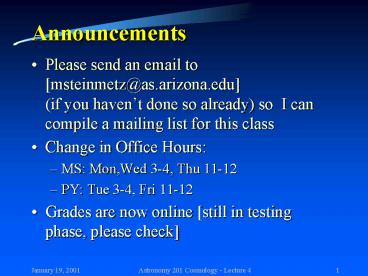Announcements - PowerPoint PPT Presentation
1 / 21
Title:
Announcements
Description:
(if you haven't done so already) so I can compile a mailing list for this class ... Aristotle's cosmology and Hipparchus' observations) Almagest (The Great System) ... – PowerPoint PPT presentation
Number of Views:88
Avg rating:3.0/5.0
Title: Announcements
1
Announcements
- Please send an email to msteinmetz_at_as.arizona.edu
(if you havent done so already) so I can
compile a mailing list for this class - Change in Office Hours
- MS Mon,Wed 3-4, Thu 11-12
- PY Tue 3-4, Fri 11-12
- Grades are now online still in testing phase,
please check
2
Lecture 4History of Cosmology IIThe
Renaissance
3
Aristotle (350 B.C.) First coherent physical
model
- Everything on Earth composed of four elements
earth, water, air and fire - Each of these elements moves differently earth
toward the center of the Universe, fire away from
the center, water and air occupy the space
between. - Earth at the center of the Universe
- Objects of different composition fall differently
- Concept of force Motions that deviate from the
natural motion of the element must be sustained
by a force.
4
Aristotles cosmology
- In contrast to Earthly motions, celestial motions
do continue indefinitely ? two types of motion
limited, straight towards/away from the center
(Earthly realm) and continuing on circles in the
heavens - Celestial bodies cannot be composed of Earthly
elements ? ether as a fifth element - limited motion on Earth/indefinite motion in the
heavens reflect imperfect Earth/perfect heavens - eternal and unchanging heavens ? Universe without
beginning or end - Universe has a finite size
5
Ptolemy (100 A.D.) defines the cosmology for
the next 1500 years
- Assembled the astronomical knowledge (basically
Aristotles cosmology and Hipparchus
observations) ? Almagest (The Great System) - Expanded and improved the models
- Patched up inconsistencies ? Epicycle theory
- but at the expense of giving up simplicity
6
Retrograde motion
7
Epicycle model
8
Ptolemy (100 A.D.) defines the cosmology for
the next 1500 years
- Assembled the astronomical knowledge (basically
Aristotles cosmology and Hipparchus
observations) ? Almagest (The Great System) - Expanded and improved the models
- Patched up inconsistencies ? Epicycle theory
- but at the expense of giving up simplicity
- Thomas Aquinas ? cornerstone of Christian
doctrine - Believe that all that could be discovered had
already been discovered
9
Problems of Ptolemys model
- Model couldnt fit observations
- put the Earth off center
- epicycles upon epicycles
- total of more than 100 epicycles
- Nevertheless errors in the predicted positions of
planets accumulated to several degrees by 1400
A.D.
King Alfonso If the Lord Almighty had consulted
me before embarking upon Creation, I should have
recommended something simpler
10
The Copernican Revolution (1500)
- 15th century rediscovery of Greek scientific
thought - Shape and size of the Earth were well known among
educated people (Columbus myth) - Nicholas Copernicus De revolutionibus orbium
coelestrium On the Revolution of Heavenly
Spheres put the Sun at the center ?
heliocentric world model inspired by the work of
Aristarchus ?
11
Why is the heliocentric model so attractive ?
- Its simple
- It naturally explains why the inner planets
Mercury and Venus never travel far from the
Sun - reproduces much better the observed change in
brightness of planets - It provides a natural explanation for the seasons
- It provides a natural explanation of retrograde
motions without relying on epicycles
12
Heliocentric model
13
Problems of the heliocentric model
- Against Christian Scriptures
- New discovery
- Predicts parallaxes ?observation
- Problem rotating Earth ?Aristotles physics
- Less accurate than the Ptolemaic model ? working
model required even more epicycles - Question Why did he published his work only near
the end of his life ? Was he afraid of the
authority of the Church or was he embarrassed
because of the failure of his model ?
14
Just being smart is not enough ...
- Better data
- Final touch-up of the model
- Promotion of the new model
- Tycho Brahe
- Johannes Kepler
- Galileo Galilei
15
Tycho Brahe (1546-1601)
- Last of the great naked-eye observers
- exceptionally careful and systematic observer ?
first modern scientist - Earth at center, planets orbit the Sun
- detailed measurement of Mars orbit over 30 years
- Observed comets and parallax of comets ? Comet
behind the orbit of the Moon - Observed a supernova new star in Cassiopeia,
no parallax measurable ? supernova must be on
celestial sphere
? Challenge of the Aristotelian idea of the
perfect, eternal, unchanging heavens
16
Johannes Kepler (1571-1630)
- Tychos successor in Prague
- He realized that neither the Ptolemaic nor
Tychos nor the heliocentric model can fit
Tychos data within the stated accuracy - Proposal planets move on ellipses, not circles
Circle distance to the center is constant
17
Johannes Kepler (1571-1630)
- Tychos successor in Prague
- He realized that no model can fit Tychos data
within the stated accuracy - Proposal planets move on ellipses, not circles
18
Keplers three laws of planetary orbits
- Keplers first law Planets orbit the Sun in an
- ellipse, with the Sun at one focus.
19
Keplers three laws of planetary orbits
- Keplers second law The line from the Sun to
- the planet sweeps out an equal area in an equal
- time. Thus planets move faster if they are nearer
- the Sun.
20
Keplers three laws of planetary orbits
- Keplers third law The square of the period of
- the orbit is equal to the cube of the semimajor
- axis of the ellipse.
21
Announcements
- Please send an email to msteinmetz_at_as.arizona.edu
(if you havent done so already) so I can
compile a mailing list for this class - Change in Office Hours
- MS Mon,Wed 3-4, Thu 11-12
- PY Tue 3-4, Fri 11-12
- Grades are now online still in testing phase































